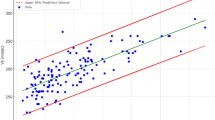Abstract
The prediction of liquefaction potential of soil due to an earthquake is an essential task in civil engineering. In this paper, random forest (RF) method is introduced and investigated for the prediction of seismic liquefaction potential of soil based on the cone penetration test data. RF has been proposed on the basis of classification and regression trees with “ensemble learning” strategy. The RF models were developed and validated on a relatively large dataset comprising 226 field records of liquefaction performance and cone penetration test measurements. The database contains the information about depth of potentially liquefiable soil layer (D), cone tip resistance (\(q_{\text{c}}\)), sleeve friction ratio (\(R_{\text{f}}\)), effective vertical stress (\(\sigma_{0}^{\prime }\)), total vertical stress (\(\sigma_{0}\)), maximum horizontal ground surface acceleration (\(\alpha_{\hbox{max} }\)) and earthquake magnitude (\(M_{\text{w}}\)). Two RF models (Model I and Model II) are developed for predicting the occurrence and non-occurrence of liquefaction on the basis of combination of above input parameters. The results of RF models have been compared with the available artificial neural network (ANN) and support vector machine (SVM) models. It is shown that the proposed RF models provide more accurate results than the ANN and SVM models proposed in the literature. The developed RF provides a viable tool for civil engineers to determine the liquefaction potential of soil.



Similar content being viewed by others
References
Breiman L (1996) Bagging predictors. Mach Learn 24:123–140. doi:10.1007/BF00058655
Breiman L (2001) Random forests. Mach Learn 45:5–32. doi:10.1023/A:1010933404324
Calderoni L, Ferrara M, Franco A, Maio D (2015) Indoor localization in a hospital environment using random forest classifiers. Expert Syst Appl 42:125–134
Dietterich TG (2000) An experimental comparison of three methods for constructing ensembles of decision trees: bagging, boosting, and randomization. Mach Learn 40:139–157. doi:10.1023/A:1007607513941
Gandomi AH, Fridline MM, Roke DA (2013) Decision tree approach for soil liquefaction assessment. Sci World J. doi:10.1155/2013/346285
Goh AT (1996) Neural-network modeling of CPT seismic liquefaction data. J Geotech Eng 122:70–73. doi:10.1061/(ASCE)0733-9410(1996)122:1(70)
Goh AT, Goh S (2007) Support vector machines: their use in geotechnical engineering as illustrated using seismic liquefaction data. Comput Geotech 34:410–421. doi:10.1016/j.compgeo.2007.06.001
Ham J, Chen Y, Crawford MM, Ghosh J (2005) Investigation of the random forest framework for classification of hyperspectral data. IEEE Trans Geosci Remote Sens 43:492–501. doi:10.1109/TGRS.2004.842481
Ho TK (1998) The random subspace method for constructing decision forests. IEEE Trans Pattern Anal Mach Intell 20:832–844. doi:10.1109/34.709601
Javadi AA, Ahangar-Asr A, Johari A, Faramarzi A, Toll D (2012) Modelling stress–strain and volume change behaviour of unsaturated soils using an evolutionary based data mining technique, an incremental approach. Eng Appl Artif Intell 25:926–933
Joelsson SR, Benediktsson JA, Sveinsson JR (2006) Feature selection for morphological feature extraction using random forests. In: IEEE, proceedings of the 7th Nordic, signal processing symposium, 2006. NORSIG 2006, pp 10–13
Juang CH, Yuan H, Lee D-H, Lin P-S (2003) Simplified cone penetration test-based method for evaluating liquefaction resistance of soils. J Geotech Geoenviron Eng 129:66–80. doi:10.1061/(ASCE)1090-0241(2003)129:1(66)
Kohestani VR, Hassanlourad M (2015) Modeling the mechanical behavior of carbonate sands using artificial neural networks and support vector machines. Int J Geomech. doi:10.1061/(ASCE)GM.1943-5622.0000509
Liao SS, Veneziano D, Whitman RV (1988) Regression models for evaluating liquefaction probability. J Geotech Eng 114:389–411. doi:10.1061/(ASCE)0733-9410(1988)114:4(389)
Liaw A, Wiener M (2002) Classification and regression by random forest. R News 2:18–22
Livingston G, Piantedosi M, Kurup P, Sitharam T (2008) Using decision-tree learning to assess liquefaction potential from CPT and Vs. In: Proceedings of the 4th geotechnical earthquake engineering and soil dynamics congress, pp 1–10
Mendez G, Lohr S (2011) Estimating residual variance in random forest regression. Comput Stat Data Anal 55:2937–2950
Oommen T, Baise LG, Vogel R (2010) Validation and application of empirical liquefaction models. J Geotech Geoenviron Eng 136:1618–1633
Pal M (2006) Support vector machines-based modelling of seismic liquefaction potential. Int J Numer Anal Meth Geomech 30:983–996. doi:10.1002/nag.509
Samui P (2007) Seismic liquefaction potential assessment by using relevance vector machine. Earthq Eng Eng Vib 6:331–336. doi:10.1007/s11803-007-0766-7
Samui P, Karthikeyan J (2014) The use of a relevance vector machine in predicting liquefaction potential. Indian Geotech J 44:458–467. doi:10.1007/s40098-013-0094-y
Samui P, Sitharam T (2011) Machine learning modelling for predicting soil liquefaction susceptibility. Nat Hazards Earth Syst Sci 11:1–9. doi:10.5194/nhess-11-1-2011
Seed HB, Idriss IM (1971) Simplified procedure for evaluating soil liquefaction potential. J Soil Mech Found Div 97:1249–1273
Verikas A, Gelzinis A, Bacauskiene M (2011) Mining data with random forests: a survey and results of new tests. Pattern Recogn 44:330–349. doi:10.1016/j.patcog.2010.08.011
Vincenzi S, Zucchetta M, Franzoi P, Pellizzato M, Pranovi F, De Leo GA, Torricelli P (2011) Application of a random forest algorithm to predict spatial distribution of the potential yield of Ruditapes philippinarum in the Venice lagoon, Italy. Ecol Model 222:1471–1478. doi:10.1016/j.ecolmodel.2011.02.007
Vitorino D, Coelho S, Santos P, Sheets S, Jurkovac B, Amado C (2014) A random forest algorithm applied to condition-based wastewater deterioration modeling and forecasting. Procedia Eng 89:401–410
Watts JD, Lawrence RL, Miller PR, Montagne C (2009) Monitoring of cropland practices for carbon sequestration purposes in north central Montana by Landsat remote sensing. Remote Sens Environ 113:1843–1852. doi:10.1016/j.rse.2009.04.015
Witten IH, Frank E (2005) Data mining: practical machine learning tools and techniques. Morgan Kaufmann, Los Altos
Xue X, Yang X (2013) Application of the adaptive neuro-fuzzy inference system for prediction of soil liquefaction. Nat Hazards 67:901–917
Youd T et al (2001) Liquefaction resistance of soils: summary report from the 1996 NCEER and 1998 NCEER/NSF workshops on evaluation of liquefaction resistance of soils. J Geotech Geoenviron Eng 127:817–833. doi:10.1061/(ASCE)1090-0241(2001)127:10(817)
Author information
Authors and Affiliations
Corresponding author
Rights and permissions
About this article
Cite this article
Kohestani, V.R., Hassanlourad, M. & Ardakani, A. Evaluation of liquefaction potential based on CPT data using random forest. Nat Hazards 79, 1079–1089 (2015). https://doi.org/10.1007/s11069-015-1893-5
Received:
Accepted:
Published:
Issue Date:
DOI: https://doi.org/10.1007/s11069-015-1893-5



